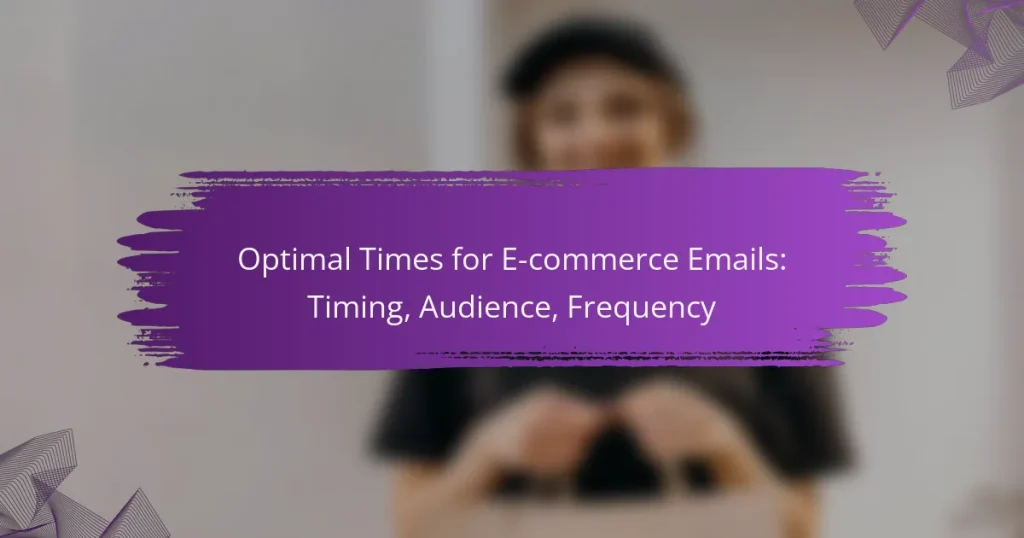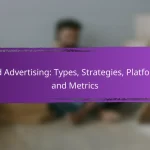Timing is crucial for e-commerce emails, with optimal send times generally falling on weekdays, especially from Tuesday to Thursday during mid-morning and early afternoon. By segmenting your audience and understanding their unique behaviors, you can further enhance engagement and open rates. Additionally, maintaining a frequency of two to four emails per month strikes the right balance, keeping your audience engaged without overwhelming them.
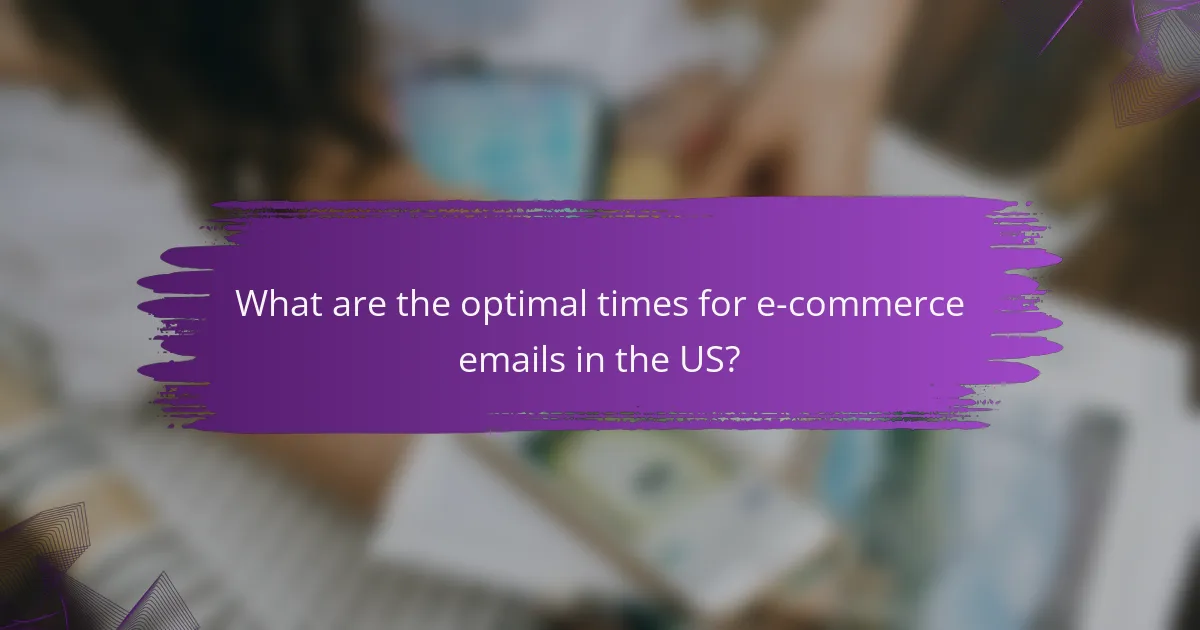
What are the optimal times for e-commerce emails in the US?
The optimal times for e-commerce emails in the US typically fall on weekdays, particularly Tuesday through Thursday, during mid-morning and early afternoon. Understanding these timings can significantly enhance open and click-through rates, leading to better engagement and sales.
Best times for sending emails
The best times for sending e-commerce emails are generally between 10 AM and 2 PM on weekdays. This timeframe captures recipients when they are most likely to check their emails, often during breaks or downtime. Avoid sending emails late in the evening or on weekends, as engagement tends to drop during these periods.
Consider segmenting your audience based on their previous engagement patterns. For instance, if certain customers have shown higher activity in the afternoon, tailor your sending times accordingly to maximize their responsiveness.
Peak engagement hours
Peak engagement hours for e-commerce emails in the US are usually around 11 AM and 1 PM. During these hours, many individuals take breaks from work, making them more likely to check and interact with their emails. Testing different times within this window can help identify the most effective slots for your specific audience.
Additionally, monitor your email analytics to adjust your strategy based on real-time data. If you notice higher open rates at a specific time, consider making that your standard for future campaigns to enhance overall performance.
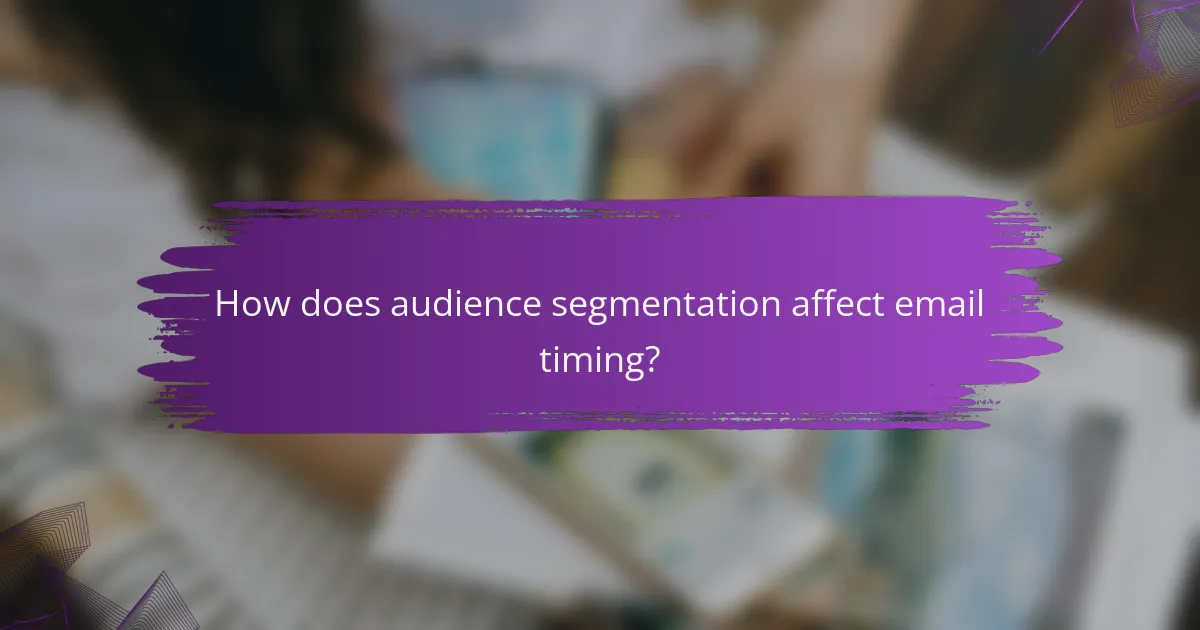
How does audience segmentation affect email timing?
Audience segmentation significantly impacts email timing by allowing marketers to tailor their messages based on specific characteristics and behaviors of different groups. By understanding when various segments are most receptive, businesses can optimize open rates and engagement.
Demographic factors influencing timing
Demographic factors such as age, location, and occupation can greatly influence the optimal timing for email campaigns. For instance, younger audiences may check their emails later in the day or during weekends, while professionals might engage more during work hours. Understanding these trends helps in scheduling emails when recipients are most likely to read them.
Additionally, geographic location plays a role; for example, emails sent to recipients in Europe may need to be timed differently than those sent to audiences in North America due to time zone differences. Tailoring your send times based on these demographics can enhance engagement rates.
Behavioral insights for timing
Behavioral insights, such as past engagement patterns and purchase history, are crucial for determining the best timing for emails. Analyzing when specific segments have previously opened emails can provide valuable data on optimal send times. For example, if a segment frequently opens emails in the evening, scheduling future campaigns for that time can improve performance.
Moreover, consider the frequency of past interactions. If a segment has shown high engagement with frequent emails, maintaining a consistent schedule may be beneficial. Conversely, for less engaged segments, spacing out communications could prevent fatigue and increase the likelihood of interaction.

What is the ideal frequency for e-commerce emails?
The ideal frequency for e-commerce emails typically ranges from two to four times per month. This balance helps maintain customer engagement without overwhelming your audience, ensuring your messages remain effective and welcomed.
Recommended email frequency
For most e-commerce businesses, sending emails once a week is a solid strategy, amounting to about four emails per month. However, brands with high-value content or promotions may benefit from increasing this frequency to twice a week. It’s essential to monitor customer responses to find the sweet spot for your specific audience.
Consider segmenting your email list to tailor frequency based on customer behavior. For instance, loyal customers may appreciate more frequent updates, while new subscribers might prefer a slower introduction to your brand.
Impact of frequency on engagement
Email frequency directly influences engagement rates, including open and click-through rates. Sending emails too frequently can lead to higher unsubscribe rates, while infrequent communication may cause your audience to forget your brand. Striking the right balance is crucial for maintaining interest.
Testing different frequencies can provide insights into how your audience responds. A/B testing can help determine whether your customers prefer weekly or bi-weekly emails, allowing you to adjust your strategy based on actual data rather than assumptions.
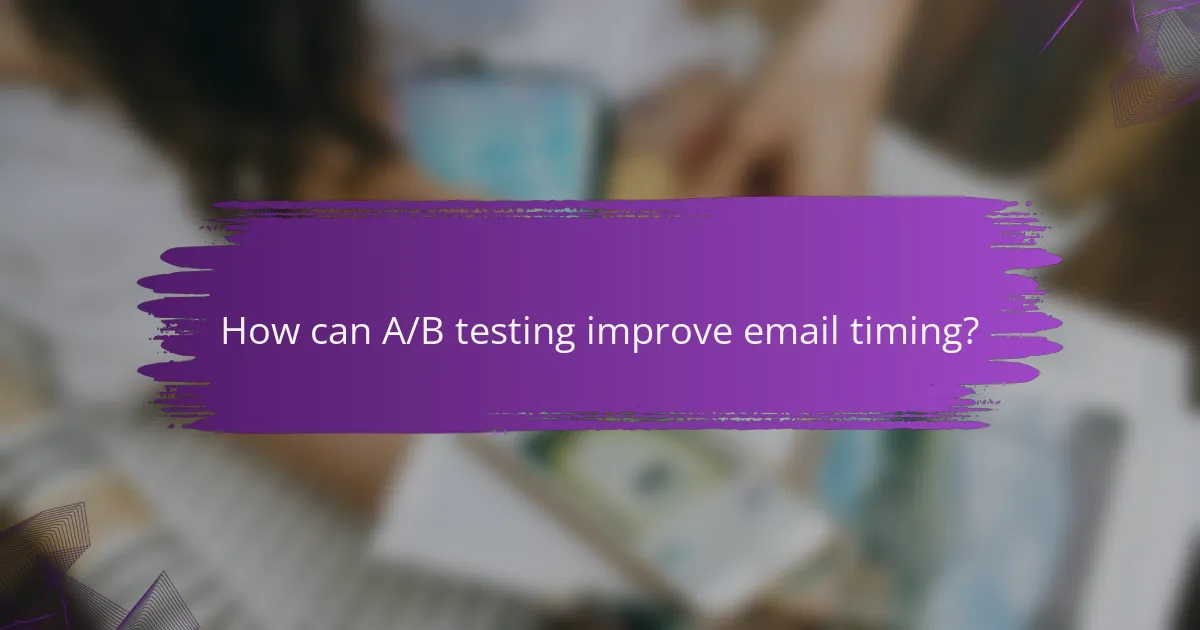
How can A/B testing improve email timing?
A/B testing can significantly enhance email timing by allowing marketers to compare different send times and identify when their audience is most responsive. By analyzing the performance of emails sent at various times, businesses can optimize their strategies to increase open and click-through rates.
Benefits of A/B testing
A/B testing provides clear insights into customer behavior, enabling businesses to tailor their email campaigns effectively. By experimenting with different send times, companies can discover optimal periods that yield higher engagement rates, leading to improved sales and customer retention.
Additionally, A/B testing helps in minimizing risks associated with email campaigns. Instead of relying on assumptions, marketers can base their decisions on actual data, ensuring that resources are allocated efficiently and effectively.
Key metrics to analyze
When conducting A/B tests on email timing, focus on metrics such as open rates, click-through rates, and conversion rates. Open rates indicate how many recipients engaged with the email, while click-through rates show how many took action, such as visiting a website or making a purchase.
It’s also important to track unsubscribe rates and bounce rates, as these can provide insights into audience satisfaction and email deliverability. A combination of these metrics will give a comprehensive view of the effectiveness of different email timing strategies.
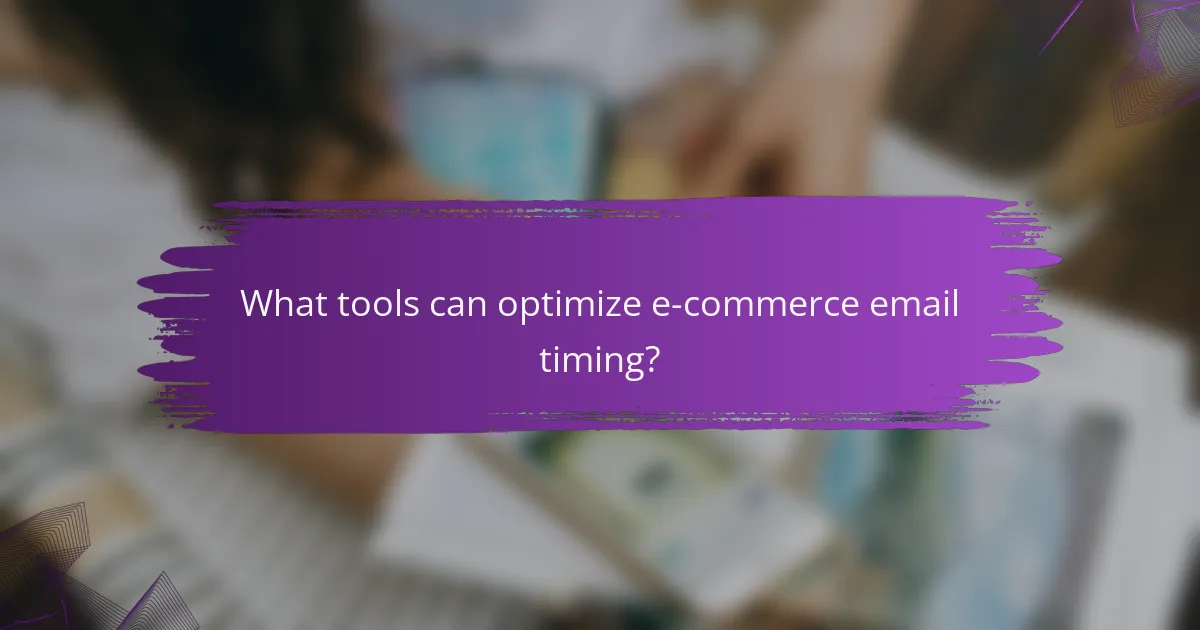
What tools can optimize e-commerce email timing?
To enhance the timing of e-commerce emails, various tools can assist in analyzing customer behavior and automating delivery schedules. These tools help identify optimal send times based on audience engagement patterns, ensuring that emails reach customers when they are most likely to interact.
Popular email marketing platforms
Several email marketing platforms offer features designed to optimize email timing. Services like Mailchimp, Klaviyo, and Constant Contact provide analytics that track open rates and engagement, allowing businesses to determine the best times to send emails based on historical data.
These platforms often include A/B testing capabilities, enabling marketers to experiment with different send times and assess which yields the highest engagement. Utilizing these insights can significantly improve the effectiveness of email campaigns.
Automation tools for timing
Automation tools are essential for managing email timing efficiently. Platforms like HubSpot and ActiveCampaign allow users to set up automated workflows that send emails based on specific triggers, such as customer behavior or time zones.
For instance, a welcome email can be automatically sent immediately after a customer signs up, while promotional emails can be scheduled to align with peak shopping times. This ensures that messages are timely and relevant, enhancing the likelihood of customer engagement.
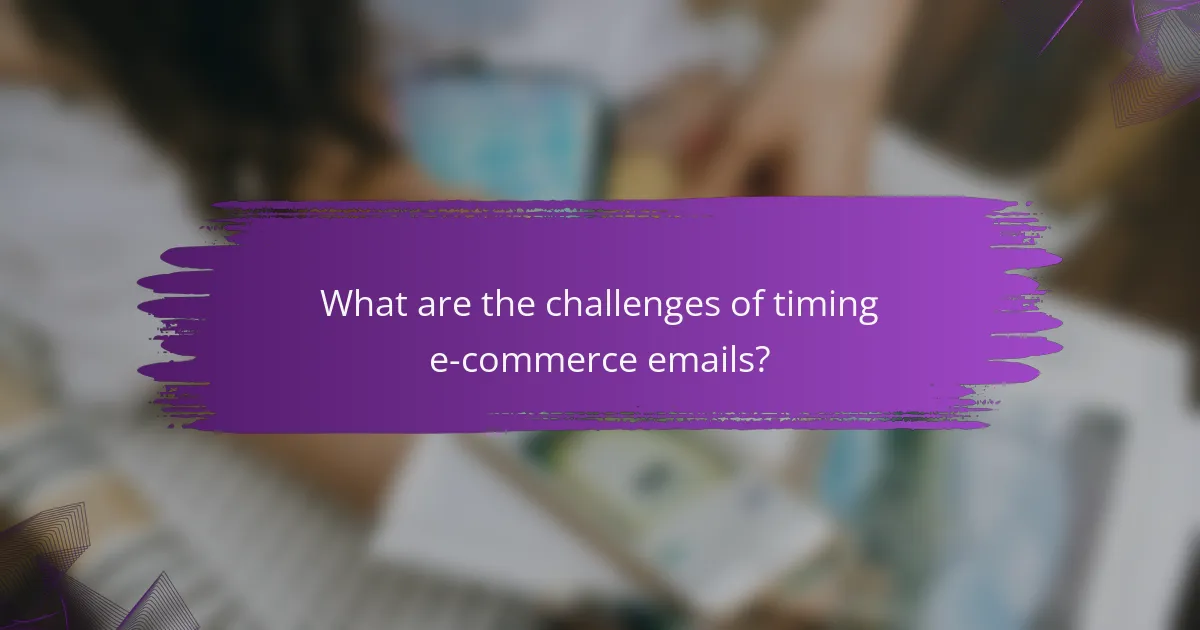
What are the challenges of timing e-commerce emails?
Timing e-commerce emails effectively is crucial yet challenging due to various factors like audience behavior, market trends, and competition. Misjudging the optimal time can lead to lower open rates and reduced engagement, impacting sales and customer retention.
Common pitfalls in timing
One common pitfall is sending emails during peak hours when inboxes are crowded, leading to your message being overlooked. Additionally, failing to consider the time zone differences of your audience can result in emails arriving at inconvenient times, further diminishing engagement.
Another issue arises from inconsistent email frequency. Sending too many emails can overwhelm recipients, while infrequent communication may cause your brand to be forgotten. Striking the right balance is essential for maintaining interest without causing annoyance.
Strategies to overcome timing issues
To improve timing, analyze your audience’s behavior through metrics like open rates and click-through rates. Testing different send times can help identify when your specific audience is most responsive. Consider segmenting your email list based on time zones to ensure messages reach recipients at optimal times.
Establish a consistent email schedule that aligns with your audience’s preferences. A/B testing can also be effective; try varying the frequency and timing of your emails to find the sweet spot that maximizes engagement. Utilize automation tools to help manage and optimize your email campaigns based on real-time data.
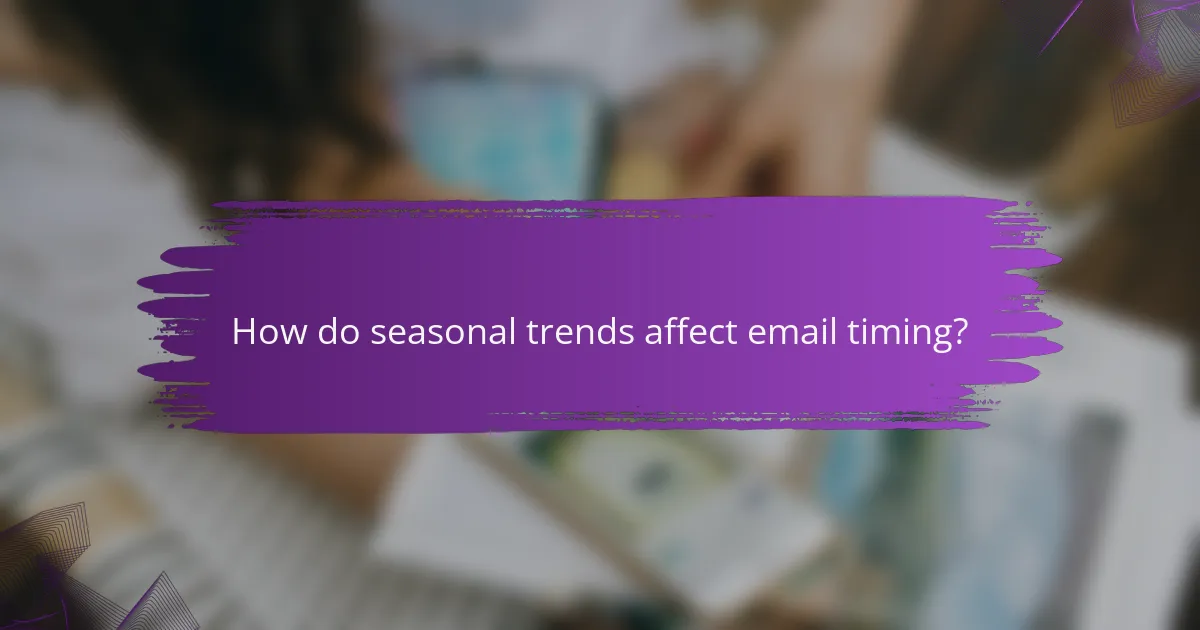
How do seasonal trends affect email timing?
Seasonal trends significantly influence the timing of e-commerce emails, as consumer behavior shifts throughout the year. Understanding these trends helps businesses optimize their email campaigns for better engagement and conversion rates.
Impact of holidays on email campaigns
Holidays are pivotal moments for e-commerce email campaigns, often leading to increased sales and customer engagement. For instance, sending promotional emails a week before major holidays like Christmas or Black Friday can capture early shoppers and boost visibility.
Consider segmenting your audience based on past holiday shopping behavior. Tailoring messages to specific groups can enhance relevance and effectiveness, leading to higher open and click-through rates.
Seasonal engagement patterns
Consumer engagement varies with the seasons, influenced by factors such as weather and holidays. For example, summer months may see lower engagement due to vacations, while back-to-school season can trigger a spike in interest for certain products.
To adapt, analyze past email performance data to identify peak engagement periods. Adjust your sending frequency accordingly, increasing it during high-engagement seasons and scaling back during slower periods to avoid overwhelming your audience.

What are the emerging trends in e-commerce email timing?
Emerging trends in e-commerce email timing focus on optimizing delivery based on customer behavior and preferences. Brands are increasingly leveraging data analytics to determine the best times to send emails, aiming to enhance engagement and conversion rates.
Personalization in email timing
Personalization in email timing involves tailoring the send times based on individual customer behaviors and preferences. For instance, analyzing past purchase data and email interaction can reveal when a specific customer is most likely to engage with emails. This can lead to higher open and click-through rates.
To implement personalized timing, consider segmenting your audience based on their activity patterns. For example, if a segment typically engages with emails in the evening, schedule your campaigns accordingly. Avoid generic send times that may not resonate with all customers.
Use of AI for optimal timing
Artificial intelligence (AI) is increasingly utilized to determine optimal email timing by analyzing vast amounts of customer data. AI algorithms can predict the best times to send emails based on factors such as previous engagement, demographics, and even external events like holidays.
Using AI tools can help automate the timing process, ensuring emails reach customers when they are most likely to engage. However, it’s essential to continuously monitor performance and adjust strategies based on real-time feedback to maximize effectiveness. Consider A/B testing different send times to refine your approach further.
